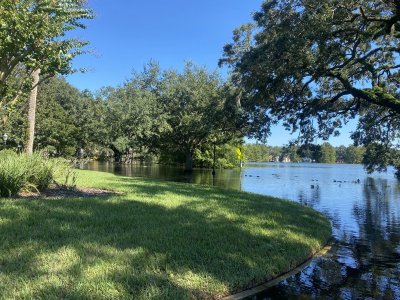Yes, rebuilding can be done with a much higher margin of durability, but it requires re-thinking how buildings function and how buildings and landscaping should look. The code needs to be revised to take the future hurricane probability into account, not just to work for managing what we've already seen. Right now you can't go back to the old way of building Florida homes completely out of Cypress (the ideal stick-build structural material because water exposure strengthens it; this is why so many homes built in Florida before 1921 are still standing.) However, replanting Cypress liberally throughout the Florida wetlands would sure help in many ways .No one would be able to build with it for about 100 years until the trees mature, but in the meantime those trees and the marshes they stand in will help sequester pollutants and absorb storm surges.
Right now the future of coastal home new construction in Florida is raised ICF with pile-driven concrete foundations, as was done on the "Sand Palace" house that survived Michael in Mexico Beach. The pilings on that house are driven 30 feet deep, and the roof is tied down six ways to Sunday; steel hurricane anchors on every join, and steel cabling anchored to the pilings and running up through the walls, over the roof trusses and down the other side. Most of the windows are smaller than you might expect, and protrusions off the house are minimal. Some people have said it isn't very attractive, but it's built to take 250 mph winds, which sounds like a fair trade to me. But, if we add more reinforced concrete to the buildings themselves, flat concrete on the ground needs to be reduced, so that runoff is reduced. Garage doors are a weak point for wind-resistance on a typical home, so they need to be double-doored for flow-through if they are under the home, or detached if the home is one-story, so that wind that gets into the garage does not also get into the house.
It *is* more expensive to build this way, but that's a trade-off in square footage and finish. In Florida that's mostly about developers rather than homeowners doing their own builds, so I propose that developers should have to contribute to a statewide self-insurance endowment -- if you build it for profit, then you need to put some skin in the game of how much it will cost to repair if it's damaged by the climate; the stronger you build, the less you have to put in. The state and local communities need to draw a literal line in the sand with developers and insist on high-impact designs in sustainable projects that reduce runoff and resist wind. Retention pond requirements are a good start, but not enough. New land clearances should not be happening as often; there are plenty of areas where land can be re-used with existing infrastructure; so builders should be encouraged to do more with infill projects and renovations by limiting permitting that requires leveling of undeveloped land. Setbacks need to be increased to allow better drainage, and permiable ground surfaces should be required wherever they are feasible. The state also is a very good place to develop new solar technologies, but no one wants to invest as long as the state allows utilities to penalize homeowners who install solar.
